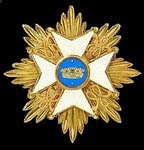First raised in Piedmont in 1643 as the guard of Prince Thomas of Savoy, Prince of Carignan. Given by the Prince of Carignan to Louis XIV in 1659 and took the name of Soissons. Took the name of Perche from 1691 to 1744 and was then absorbed into the Regiment of Gardes Lorraines as its first battalion. 2 battalions. Ranked 30th in the SYW.
My version of the flags is based closely on that depicted in the 1757 Manuscript.
And next my translation of the text in Susane Volume 5 on the regiment in the SYW:
The regiment took part in the first gathering of French troops at Wesel in 1757, from 27th April to the 21st of May. On the 24th July it fought at Hastenbeck, and then took part in the taking of Minden and Hanover, and the pursuit of the Anglo-Hanoverian army to Zell. In January 1758, the Convention of Closterseven by which this army was supposed no longer to serve, having been violated, the Gardes Lorraines marched to Brèmes, attacked the Hanoverian vanguard at Riddershade and tool possession of this post. They then rallied the corps of the Duke of Broglie who entrusted them with the guard of the town of Hoya on the Weser. On the 23rd February the regiment was attacked there by the whole army of Prince Ferdinand of Brunswick. Le Comte de Chabot, who commanded at Hoya, evacuated and burned the suburb beyond the Weser, and sent an aide de camp to the Duc de Broglie to ask for reinforcements. But meanwhile the Prince Ferdinand crossed the Weser on rafts with part of his army and came to attack the Gardes Lorraines by all the access ways of this open town. The resistance was long and vigorous; the Chevalier de Beavau and the Lieutenant-Colonel de Chastellar, of the same family as the old Sallières, did all that it was possible to do; but it was necessary to give up the place. The regiment, which had lost 15 officers and had only 300 men fit to fight, retreated towards Brème. On arriving at the gates of that town, they discovered that the enemy had occupied it that same day. They had to retrace their steps. The regiment however managed to take Wilshofen; there it crossed the Weser, burned the bridge and retired to Dulmen without allowing themselves to be attacked by the light troops who were harrassing them. They reached Osnabruck and joined the army of the Comte de Clermont who had replaced Richelieu in command. The generals considered the regiment too weakened to continue the campaign and sent it back to France.
The Gardes Lorraines stayed in Lunéville until 1761. They returned to Germany that year and were stationed with the army of the Prince de Soubise. On the 3rd July, in the combat of Werle, the elite companies stood out in the attack on the mill and chateau of Schaffhausen. The regiment also served in the campaign in Germany in 1762 and at the peace came to Bitche. In May 1763 the first battalion went into garrison in Luneville and the second in Metz.
And this was the uniform in the SYW:





















